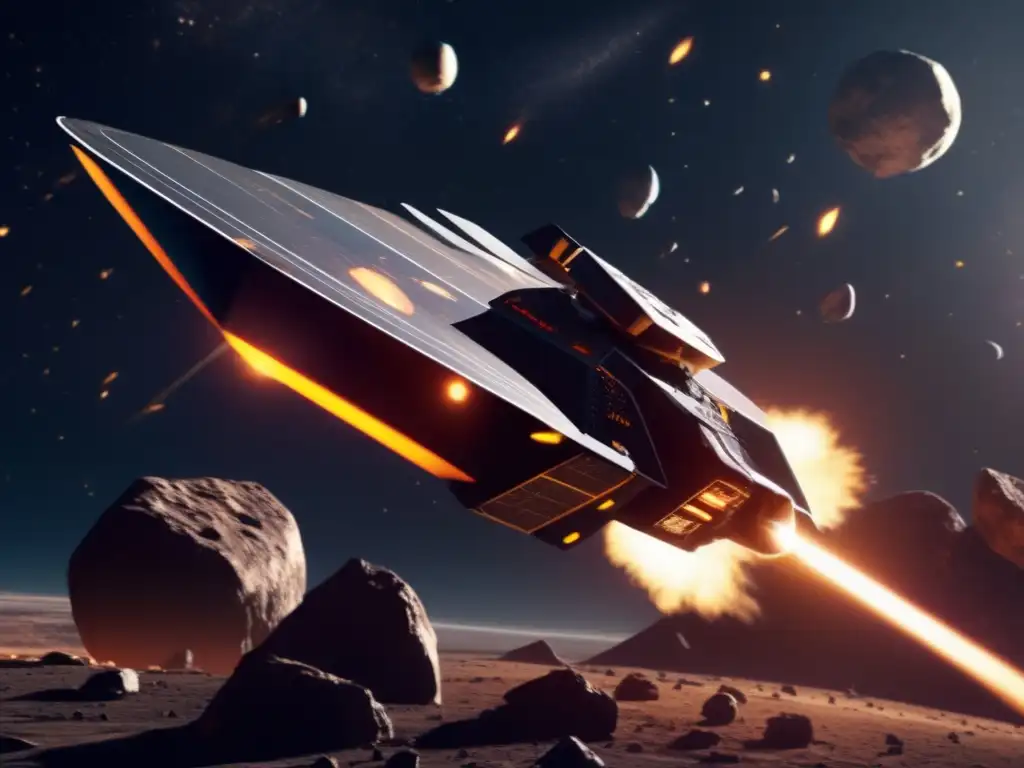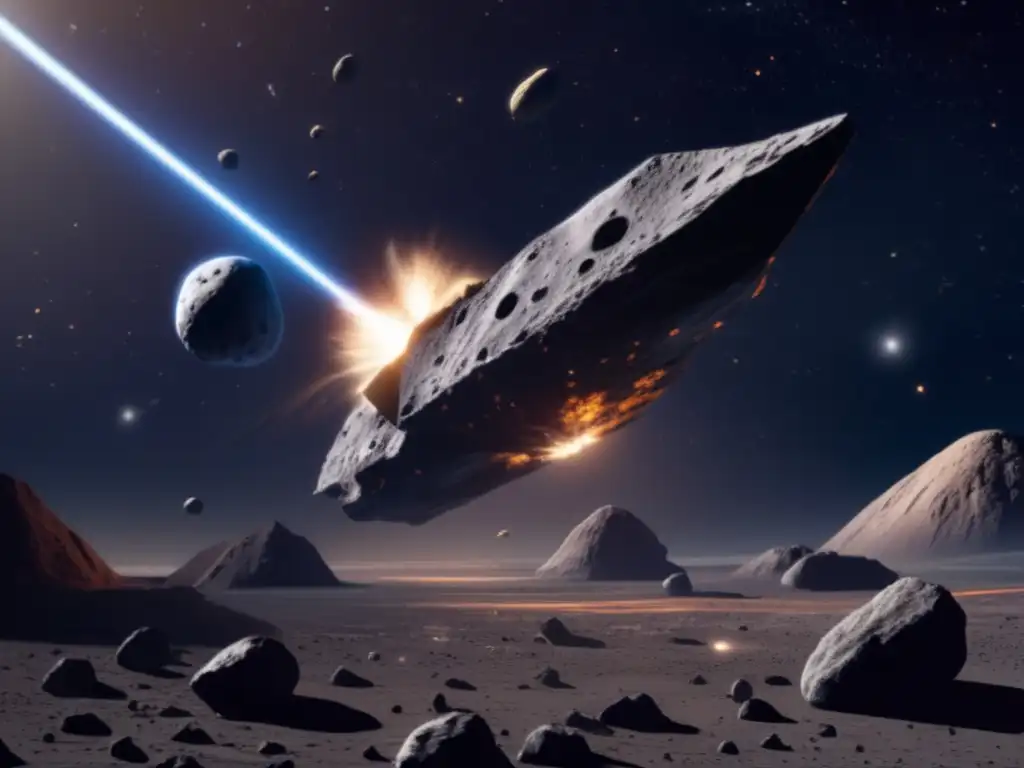Asteroid Showdown: Techniques For Planetary Defense

Introduction
Asteroids have been a fascinating topic of study for astronomers and space enthusiasts for decades. However, it is important to consider the potentially catastrophic impacts that asteroids can have on our planet if they collide with Earth. With our increasing dependence on technology and infrastructure, it is crucial that we develop and implement effective strategies to protect our planet from these extraterrestrial threats. This article explores some of the techniques that have been proposed and utilized for planetary defense against asteroids.
Nuclear Explosions as a Defense Strategy

The Orion Project
The idea of using nuclear explosions to deflect or destroy an incoming asteroid has been proposed and studied for many years. One of the most prominent proposals was the Orion Project, which sought to use nuclear explosions to propel a spacecraft toward an asteroid. The force of the explosions would deflect the asteroid's trajectory away from Earth.
The Hypervelocity Asteroid Mitigation Mission
The Hypervelocity Asteroid Mitigation Mission (HAMM) was a NASA mission proposal that aimed to use nuclear explosions to destroy an asteroid. The spacecraft would be equipped with nuclear warheads that would detonate upon impact with the asteroid, breaking it into smaller pieces that would be less likely to cause destruction if they collided with Earth.
The Potential Risks and Challenges of Nuclear Explosions
While nuclear explosions have shown promise in simulations and studies, there are also significant risks and challenges associated with this technique. The use of nuclear devices in space raises concerns about radiation exposure, international cooperation, and the possibility of creating debris fields that could pose a risk to other spacecraft.
Gravity Tractor Technique

How does the Gravity Tractor Technique work?
The Gravity Tractor Technique involves the deployment of a spacecraft near an asteroid that has been identified as potentially hazardous. The spacecraft's gravitational pull would gently exert enough force on the asteroid to gradually alter its trajectory, avoiding any potential collision with Earth.
Advantages and Challenges of Gravity Tractor Technique
The Gravity Tractor Technique is a relatively low-risk strategy that does not involve the use of explosives or other potentially harmful technologies. However, it is also a slow and gradual process that may not be effective for large or rapidly approaching asteroids.
Examples of the Gravity Tractor Technique in Action
In 2005, NASA's Deep Impact spacecraft used a variation of the Gravity Tractor Technique to deflect the trajectory of comet Tempel 1. While the spacecraft did not possess the necessary strength to completely alter the comet's trajectory, it did demonstrate the effectiveness of this technique in altering the path of celestial bodies.
Kinetic Impactor Strategy

The DART Mission
The Kinetic Impactor Strategy involves the use of a spacecraft equipped with a kinetic energy impactor. The spacecraft is deployed near an incoming asteroid, and the impactor is used to collide with the asteroid at high velocity. The force of the collision would alter the asteroid's trajectory, avoiding a collision with Earth.
The Potential Risks and Concerns of Kinetic Impactor Strategy
The Kinetic Impactor Strategy is a relatively straightforward and effective technique that has been proposed and studied extensively. However, there are still risks associated with this approach, including the possibility of creating dangerous debris fields and the challenge of accurately targeting the asteroid.
The Upcoming DART Mission
The upcoming Double Asteroid Redirection Test (DART) mission, scheduled for launch in late 2021, will test the Kinetic Impactor Strategy on a small asteroid named Didymos. The spacecraft will collide with the asteroid at high velocity and measure the resulting changes in its trajectory, providing valuable data for future planetary defense efforts.
Frequently Asked Questions

-
Can asteroids be destroyed?
Yes, there are strategies that involve the destruction of asteroids, such as the use of nuclear explosions or kinetic impactors. However, these techniques also carry potential risks and challenges.
-
How much damage can an asteroid cause?
The amount of damage caused by an asteroid would depend on its size, speed, and trajectory. An asteroid that collides with Earth could cause destruction on a regional or even global scale.
-
How do we identify potentially hazardous asteroids?
Astronomers use a variety of telescopes and detection methods to identify and track potentially hazardous asteroids. The Near-Earth Object program, managed by NASA, is one example of a program dedicated to identifying and monitoring asteroids that could pose a threat to Earth.
-
How much time do we have to prepare for an asteroid impact?
The amount of time we have to prepare for an asteroid impact would depend on the size and trajectory of the asteroid. Some asteroids may be detected years or even decades before they approach Earth, while others may not be noticed until they are too close to avoid a collision.
-
What can I do to support planetary defense efforts?
There are a variety of ways to get involved and support planetary defense efforts, such as donating to organizations dedicated to space exploration and research, advocating for increased funding for asteroid detection and mitigation, and staying informed on the latest developments in this field.
Conclusion
Planetary defense against asteroids is a critical area of study and research, with potentially catastrophic consequences if we do not take appropriate measures. While there are a variety of techniques that have been proposed and studied, there is no single approach that will work effectively in all circumstances. It is essential that we continue to invest in research and development in this field to protect our planet from this extraterrestrial threat.
We would like to hear your thoughts and feedback on this article. Please leave a comment or share this article on social media to encourage others to learn more about planetary defense against asteroids at Asteroid Realm.
Additional Resources

If you are interested in learning more about planetary defense against asteroids, we recommend the following resources:
 Guarding The Galaxy: How We Shield Earth From Asteroids
Guarding The Galaxy: How We Shield Earth From Asteroids Asteroid Avengers: Current Techniques In Planetary Defense
Asteroid Avengers: Current Techniques In Planetary Defense The Sky Is Not Falling: How We Defend Against Asteroids
The Sky Is Not Falling: How We Defend Against AsteroidsIf you want to discover more articles similar to Asteroid Showdown: Techniques For Planetary Defense, you can visit the Planetary Defense category.
Leave a Reply

Articulos relacionados: